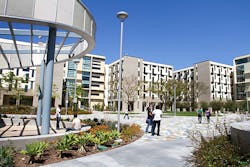Not all locksmiths own their business and serve the public. Institutional locksmiths also have a rightful place along with their traditional locksmith counterparts. While job descriptions may vary slightly, servicing procedures for both institutional and traditional locksmiths can be quite similar.
Lisa Bickmore is an institutional locksmith at California State University, Fullerton (CSU, Fullerton). As the number of school invasions mounted, Lisa Bickmore was given the task of adding security to approximately 450 doors throughout the campus. The primary objective was to allow students or faculty to lock down classroom and lab doors campus-wide as quickly as possible in case of an active shooter situation.
Existing locks on campus doors contained either an assortment of different exit devices or Sargent cylindrical leversets. None of the variety of hardware was electrified. The existing cylindrical lever lock function was mechanical locking or unlocking by key on the exterior (hallway) side of the door. Exit devices contained a mechanical hold-down feature with no quick way to release the latch in an emergency.
Cost was also an objective due to budget restrictions. The final solution was a combination involving mechanical and electronic applications. Parts for Sargent lever locks are available to change the function from classroom to exterior door operation. Inner passage levers were replaced with levers which accept a thumb piece. Cylindrical lever locks can now be locked manually from inside the classrooms.
Locksmith Lisa Bickmore chose electrified Detex exit devices to replace existing exit devices. Detex exit devices covered the existing holes without requiring any additional cover plates. An electro-magnet mounted inside the Detex exit can continually hold the device in a latch retracted position. In an emergency, push buttons located close to each door can be pushed to quickly disconnect power to the electro-magnet and release the exit device latch to the locked position.
Electrifying the exit devices required wire to be pulled to each exit device. PS480B power supplies were used to control the electrified Detex exit devices. Bickmore and her locksmith crew required approximately 750 man hours to complete the installation. At this time 425 doors have been completed. Twenty-five remaining doors require major renovations to doors or frames before new hardware can be installed.
This installation shows what can be done on a limited budget to reach an objective of locking down a campus. The project cost was approximately $250,000. CSU, Fullerton estimates that they saved approximately $1 million dolars when compared to installing a full electronic lockdown system where all doors are locked from one central location. They refer to this system as "Secure In Place," where students and faculty have the option to immediately lock the area they are in to make "safe rooms" in case of any type of trouble.
Solutions described here are within the realm and knowledge range of every locksmith. Perhaps collaborating with a local electrician for wire pulling, working with an alarm company for connecting to alarm systems when required, and having your locksmith company install the hardware will be the new 'norm' for locksmiths.
About the Author

